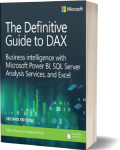The Definitive Guide to DAX
Data Science
Book Details
Book Title
The Definitive Guide to DAX
Author
Marco Russo; Alberto Ferrari
Publisher
Microsoft Press
Publication Date
2019
ISBN
9780134865867
Number of Pages
2102
Language
English
Format
File Size
23.6MB
Subject
data-science/business-intelligence
Table of Contents
- Cover Page
- Title Page
- Copyright Page
- Contents at a Glance
- Contents
- Foreword
- Acknowledgments
- Introduction to the second edition
- Introduction to the first edition
- Chapter 1. What is DAX?
- Understanding the data model
- DAX for Excel users
- DAX for SQL developers
- DAX for MDX developers
- DAX for Power BI users
- Chapter 2. Introducing DAX
- Understanding DAX calculations
- Understanding calculated columns and measures
- Introducing variables
- Handling errors in DAX expressions
- Formatting DAX code
- Introducing aggregators and iterators
- Using common DAX functions
- Conclusions
- Chapter 3. Using basic table functions
- Introducing table functions
- Introducing EVALUATE syntax
- Understanding FILTER
- Introducing ALL and ALLEXCEPT
- Understanding VALUES, DISTINCT, and the blank row
- Using tables as scalar values
- Introducing ALLSELECTED
- Conclusions
- Chapter 4. Understanding evaluation contexts
- Introducing evaluation contexts
- Testing your understanding of evaluation contexts
- Using the row context with iterators
- Understanding FILTER, ALL, and context interactions
- Working with several tables
- Using DISTINCT and SUMMARIZE in filter contexts
- Conclusions
- Chapter 5. Understanding CALCULATE and CALCULATETABLE
- Introducing CALCULATE and CALCULATETABLE
- Understanding context transition
- Understanding circular dependencies
- CALCULATE modifiers
- CALCULATE rules
- Chapter 6. Variables
- Introducing VAR syntax
- Understanding that variables are constant
- Understanding the scope of variables
- Using table variables
- Understanding lazy evaluation
- Common patterns using variables
- Conclusions
- Chapter 7. Working with iterators and with CALCULATE
- Using iterators
- Solving common scenarios with iterators
- Conclusions
- Chapter 8. Time intelligence calculations
- Introducing time intelligence
- Building a date table
- Understanding basic time intelligence calculations
- Introducing basic time intelligence functions
- Understanding semi-additive calculations
- Understanding advanced time intelligence calculations
- Working with custom calendars
- Conclusions
- Chapter 9. Calculation groups
- Introducing calculation groups
- Creating calculation groups
- Understanding calculation groups
- Understanding sideways recursion
- Using the best practices
- Conclusions
- Chapter 10. Working with the filter context
- Using HASONEVALUE and SELECTEDVALUE
- Introducing ISFILTERED and ISCROSSFILTERED
- Understanding differences between VALUES and FILTERS
- Understanding the difference between ALLEXCEPT and ALL/VALUES
- Using ALL to avoid context transition
- Using ISEMPTY
- Introducing data lineage and TREATAS
- Understanding arbitrarily shaped filters
- Conclusions
- 11. Handling hierarchies
- Computing percentages over hierarchies
- Handling parent/child hierarchies
- Conclusions
- 12. Working with tables
- Using CALCULATETABLE
- Manipulating tables
- Using tables as filters
- Creating calculated tables
- Conclusions
- 13. Authoring queries
- Introducing DAX Studio
- Understanding EVALUATE
- Implementing common DAX query patterns
- Understanding the auto-exists behavior in DAX queries
- Conclusions
- 14. Advanced DAX concepts
- Introducing expanded tables
- Understanding the difference between table filters and column filters
- Understanding ALLSELECTED and shadow filter contexts
- The ALL* family of functions
- Understanding data lineage
- Conclusions
- 15. Advanced relationships
- Implementing calculated physical relationships
- Implementing virtual relationships
- Understanding physical relationships in DAX
- Using bidirectional cross-filters
- Understanding one-to-many relationships
- Understanding one-to-one relationships
- Understanding many-to-many relationships
- Choosing the right type of relationships
- Managing granularities
- Managing ambiguity in relationships
- Conclusions
- 16. Advanced calculations in DAX
- Computing the working days between two dates
- Showing budget and sales together
- Computing same-store sales
- Numbering sequences of events
- Computing previous year sales up to last date of sales
- Conclusions
- 17. The DAX engines
- Understanding the architecture of the DAX engines
- Understanding the VertiPaq storage engine
- Understanding the use of relationships in VertiPaq
- Introducing materialization
- Introducing aggregations
- Choosing hardware for VertiPaq
- Conclusions
- 18. Optimizing VertiPaq
- Gathering information about the data model
- Denormalization
- Columns cardinality
- Handling date and time
- Calculated columns
- Choosing the right columns to store
- Optimizing column storage
- Managing VertiPaq Aggregations
- Conclusions
- 19. Analyzing DAX query plans
- Capturing DAX queries
- Introducing DAX query plans
- Capturing profiling information
- Reading VertiPaq storage engine queries
- Reading DirectQuery storage engine queries
- Reading query plans
- Conclusions
- 20. Optimizing DAX
- Defining optimization strategies
- Optimizing bottlenecks in DAX expressions
- Conclusions
- Index
- Code Snippets
